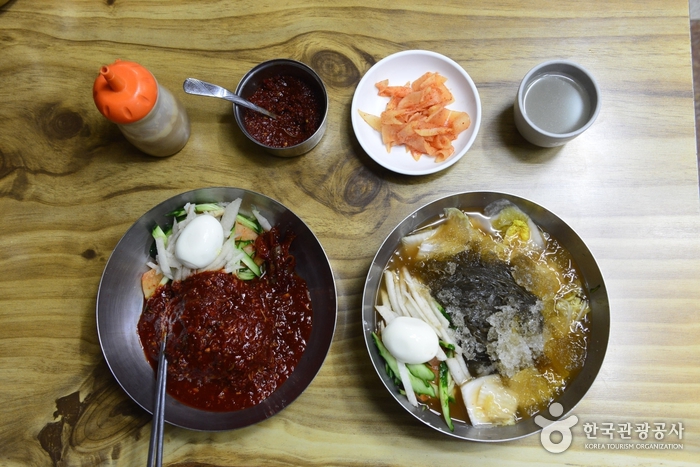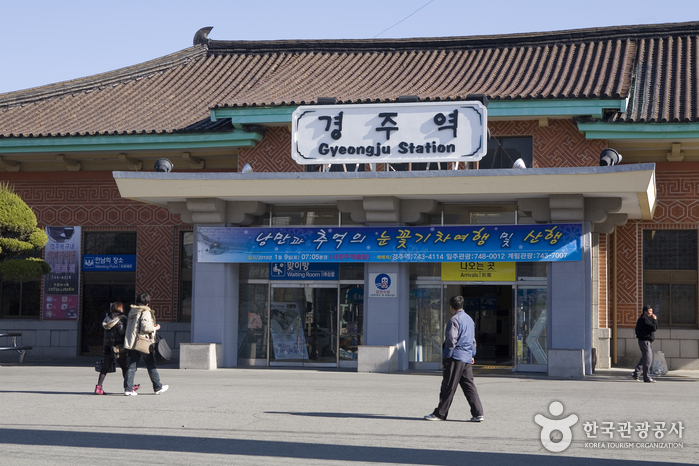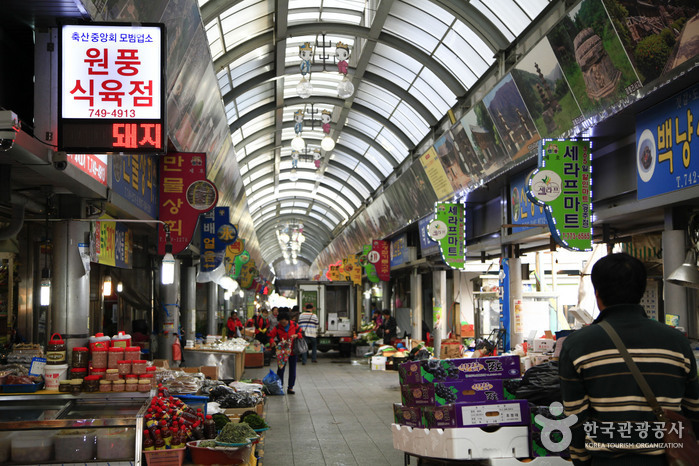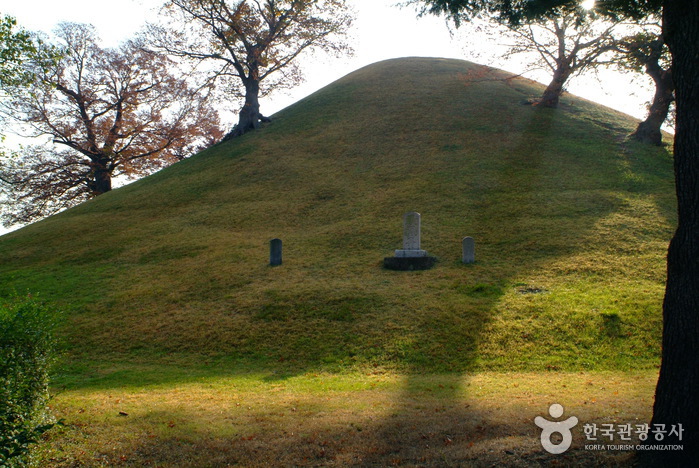141MINIHOTEL [Korea Quality] / 141미니호텔 [한국관광 품질인증]
0m 4106 2020-09-10
141, Wonhyo-ro, Gyeongju-si, Gyeongsangbuk-do
+82-10-9031-1628
'Located in Gyeongju, the capital of Silla Kingdom for 992 years, 141 Mini Hotel lets you enjoy hotel services at motel room rates. It has sauna, book café, small conference room, and business center for the convenience of its guests. The hotel staff are friendly as well. It's very conveniently located, since it's only 5 minutes away from Gyeongju Station and 10 minutes away from the Bus Terminal, both on foot. There are many popular tourist destinations in the vicinity of the hotel, including Donggung Palace, Wolji Pond, Cheomseongdae Observatory, and Bulguksa Temple.
Hwarang Guesthouse [Korea Quality] / 화랑게스트하우스[한국관광 품질인증]
72.27312435968214m 694 2023-04-13
136-1, Wonhyo-ro, Gyeongju-si, Gyeongsangbuk-do
+82-10-2473-8329
Hwarang Hostel is located near Daereungwon in Gyeongju.
The three-story guest house has ten rooms in all, and there are two types of rooms - double and quad. Every room is equipped with exclusive toilet and bathroom for the user’s convenience.
The atmosphere of the lobby on the first floor is very relaxing and cozy, furnished with various kinds of books including travel guides.
Communal PC and fax, refrigerator, and washing facility are available. Daereungwon ancient tombs, Cheomseongdae observatory, and Donggung & Wolji palace site are within walking distance from the guest house.
Hwarang Hostel boasts of the best location considering the transportation and tourist destinations. You can also rent a bike for 7,000 won a day.
ALLEY HOSTEL & GUESTHOUSE [Korea Quality] / 앨리게스트하우스 [한국관광 품질인증/Korea Quality]
237.83016207611882m 6 2021-03-29
12, Gyerim-ro 106beon-gil, Gyeongju-si, Gyeongsangbuk-do
ALLEY, a guesthouse located in the center of Gyeongju , is located only 3 min by foot from Gyeongju Station. Its supreme accessibility makes it a popular accommodation for backpackers in Gyeongju. There are no parking lots on the promise, but guests renting family rooms have access to parking services.
The first floor of the guesthouse has a lobby, common kitchen, luggage storage, and laundromat. The kitchen offers self-service complimentary breakfast. Visitors can make their own toasts and fried eggs to have with coffee and beverages. The second and third floors house guest rooms. The rooms available include single-occupancy rooms, double-occupancy rooms with single beds, double-occupancy rooms with bunk beds, triple-occupancy rooms with bunk beds, 4-person family rooms with bunk beds, and 4-person dormitory rooms with bunk beds. The family room supports up to five guests. All rooms are equipped with air conditioning and door locks, and have restrooms with shower facilities. Amenities include towels, soap, shampoo, hair conditioner, toothpaste, and hair dryer. Guests also have access to the third floor’s open-air terrace, and may store their luggage there even before their check-in. Daereungwon Ancient Tomb Complex lies about 10 min from the guesthouse, while Cheomseongdae Observatory and Donggung Palace and Wolji Pond can be found 20 min away.
Pyeongyang Naengmyeon (평양냉면)
304.73400046013853m 9638 2017-01-19
109-2, Wonhyo-ro, Gyeongju-si, Gyeongsangbuk-do
+82-54-772-2448
The restaurant of Pyeongyang Naengmyeon has been operated through two generations and thus is very famous in Gyeongju. Its noodles are hand-made from starch of Korea-grown buckwheat and potato and broth is made by deeply boiling beef bones. So, noodles are chewy and broth tastes rich and clean.
Nadul Hanok [Korea Quality] / 나들한옥 [한국관광 품질인증]
330.1991917683434m 261 2020-09-09
4-1, Jjoksaem-gil, Gyeongju-si, Gyeongsangbuk-do
+82-54-777-7738
Nadeul Hanok was opened in 2018 with brand-new facilities, in a location just a minute’s walk from Cheomseongdae Observatory in Gyeongju. You can feel a sense of healing in nature in the traditional style house, built in environment-friendly construction method with wood and earth. The ‘ㄷ’-shaped building creates a snug atmosphere and the hipped-and-gable roof and the curves of the roof tile show the traditional quiet and still flavor of a traditional Korean house. There are 7 rooms in Nadeul Hanok. Among them, the Garam, Gayeon, and Nuri Rooms are offered at 50,000 won for 2 persons during off-season so that visitors can enjoy staying in a traditional Korean house at more affordable prices. All rooms are equipped with a bathroom for better convenience and there is an individual thermostat all year round. Complimentary breakfast made of healthy convenience food is offered to all guests. The menu is composed of barley bread, fruit, coffee, juice, boiled egg, and biscuit, and is subject to change according to situation. What is good is that the breakfast can be delivered to the room if the delivery time is requested during breakfast time, which is from 8 to 9 AM.
It is possible to look around the tourist attractions near Nadeul Hanok on foot. In addition, there are CVs, fast food shops, bike rental shops, and hanbok rental shops adjacent to Nadeul Hanok, enabling a more convenient and joyful tour.
Estación de Gyeongju (경주역)
351.919467430317m 10964 2021-03-17
Wonhwa-ro 266, Gyeongju-si, Gyeongsangbuk-do.
La Estación de Gyeongju está en operaciones desde el 1° de noviembre de 1918. En noviembre de 2010 empezó a correr el tren KTX por la Estación de Singyeongju, cercana. Los horarios de los trenes a la Estación de Gyeongju están ajustado para poder aprovechar al máximo las visitas turísticas y el uso de pases ferroviarios especiales como Naeil-ro y otros. En los alrededores de la estación hay un mercado tradicional.
Mercado Seongdong de Gyeongju (경주 성동시장)
500.7461741648384m 13499 2024-02-21
Wonhwa-ro 281-beongil, 11, Gyeongju-si, Gyeongsangbuk-do
El Mercado Seongdong, situado en la ciudad de Gyeongju, provincia de Gyeongsangbuk-do, abrió en 1971 y está formado por unas 300 tiendas y 30 puestos callejeros aproximadamente.
Áreas Históricas de Gyeongju (경주역사유적지구) [Patrimonio Cultural de la Humanidad de la Unesco]
535.9243586739007m 4116 2021-05-20
Taejong-ro 757, Gyeongju-si, Gyeongsangbuk-do.
Designado como Patrimonio Cultural de la Humanidad por la Unesco en noviembre del 2000, es una zona histórica que conserva toda la historia y cultura de Gyeongju, la antigua capital de Silla (57-935). Se clasifican en un total de 5 áreas históricas.
La primera es la zona de Namsan, la cuna del arte budista de Silla. Considerado un museo al aire libre sin paredes, es un lugar en donde persiste el espíritu de Silla, y reúne 37 reliquias budistas; el pabellón Poseokjeong (Sitio Histórico Nº 1), la roca Tapgok Maaejosanggun (Tesoro Nº 201 – figuras budistas grabadas en roca), la pagoda de tres pisos de piedra del templo Cheonryongsa (Tesoro Nº 1188), la roca Chilburam Maaeseokbul (Tesoro Nº 200 - figuras budistas grabadas en roca), la roca Bulgok Seokbuljwasang (Tesoro Nº 198), etc.
La segunda es la zona de Wolseong, sitio en donde estaban los palacios de la dinastía milenaria de Silla. Se encuentran en esta área el bosque Gyerim (Sitio Histórico Nº 19), el sitio de la sala Imhaejeon, y el mejor observatorio de Asia “Cheomseongdae” (Tesoro Nacional Nº 31).
La tercera es la zona Daereungwon, el complejo de tumbas reales, los pertenecientes a los reyes, reinas y miembros de la nobleza. Durante su proceso de excavación se han encontrado coronas, pinturas de caballos míticos, variedad de cerámica, etc., entre otras reliquias que han servido como base de estudio histórico.
La cuarta es la zona en donde se encontraba instalado el famoso templo “Hwangnyongsa” (Sitio Histórico Nº 246). Y por último, la quinta zona, es el lugar en donde se establecía la fortaleza Myeonghwalsanseong (Sitio Histórico Nº 47), que se presume que fue construído hace 400 años. Estas áreas históricas de Gyeongju, designadas como Patrimonio Cultural de la Humanidad por la Unesco, comprenden un total de 52 patrimonios culturales.
Tumba Geumgwanchong (금관총)
595.1704921515711m 2437 2021-05-18
Noseo-dong, Gyeongju-si, Gyeongsangbuk-do
Geumgwanchong se ubica en Noseo-dong, Gwangju, y es una tumba de la dinastía de Silla (a.C 57 a d.C 935). Es una de las tres tumbas del centro de Gwangju que pertenece al distrito de Noseo-dong. No se conoce con certeza, pero se cree que la tumba Geumgwanchon pertenece al cuerpo de un rey anterior o posterior al rey Ji-Jeung a principios del siglo VI. Fue descubierta en septiembre de 1921 cuando el se estaban allanando las tierras para expandir la superficie. La primera reliquia que se encontró en esta tumba es una corona de oro (que en coreano se dice “geumgwan”), que le dio su nombre. También se econtraron en esta tumba ornamentos como cintos de oro, aros, pulseras, accesorios y vajilla de la época de los Tres Reinos (cuando Goguryeo, Baekje, y Silla se separaron para luego unificarse en Silla en 676 d.C). Se encontraron numerosas reliquias, más de 30.000 solo contando los accesorios. La estructura original de Geumgwanchong era de 13 metros de alto y 50 metros de diámetro. Las reliquias de esta tumba fueron transferidas y se preservan en el Museo Nacional de Gyeongju.
Tumba Cheonmachong (Parque Daereungwon) (천마총(대릉원))
647.2744222286013m 11213 2023-02-20
Gyerim-ro 9, Gyeongju-si, Gyeongsangbuk-do
En Gyeongju, en el parque Daereungwon, se pueden observar las grandes tumbas de monarcas y nobles del reino de Silla. Dentro de este parque se sitúan 23 tumbas enormes, entre las cuales se destacan las tumbas Cheonmachong y Hwangnamdaechong, las más grandes y antiguas. En una exploración y excavación del área, realizada en 1970, se descubrió la tumba Cheonmachong, dentro de la que se halló una pintura antigua de un caballo celestial. Esta pintura es la única descubierta de los antiguos tiempos de la dinastía Silla. Dentro de esta tumba se encontraron 11.526 reliquias y coronas del monarca, que fueron trasladadas al museo. Todos estos objetos muestran la vida lujosa que llevaban los reyes de aquella época. Otra atracción turística es la tumba Hwangnamdaechong, que es el enterramiento antiguo más grande. Era un sepulcro matrimonial y en su interior se hallaron los restos del rey y la reina, con más de 30.000 accesorios y adornos de oro. El aspecto más destacable de la tumba Hwangnamdaechong es que en el sepulcro de la reina se encontraron más adornos lujosos que en el del rey. De hecho, los investigadores llegaron a la conclusión de que la reina podía ostentar una alta posición social aún antes del matrimonio real, y la jerarquía de la mujer en aquellos tiempos era muy respetada. Recorriendo estas tumbas, podrá vivir en carne propia la cultura antigua, de más de 1.500 años de historia.
![141MINIHOTEL [Korea Quality] / 141미니호텔 [한국관광 품질인증]](http://tong.visitkorea.or.kr/cms/resource/21/2577221_image2_1.jpg)
![ALLEY HOSTEL & GUESTHOUSE [Korea Quality] / 앨리게스트하우스 [한국관광 품질인증/Korea Quality]](http://tong.visitkorea.or.kr/cms/resource/80/2707780_image2_1.jpg)

![Nadul Hanok [Korea Quality] / 나들한옥 [한국관광 품질인증]](http://tong.visitkorea.or.kr/cms/resource/86/2636486_image2_1.jpg)


![Áreas Históricas de Gyeongju (경주역사유적지구) [Patrimonio Cultural de la Humanidad de la Unesco]](http://tong.visitkorea.or.kr/cms/resource/03/2656603_image2_1.jpg)


 Español
Español
 한국어
한국어 English
English 日本語
日本語 中文(简体)
中文(简体) Deutsch
Deutsch Français
Français Русский
Русский